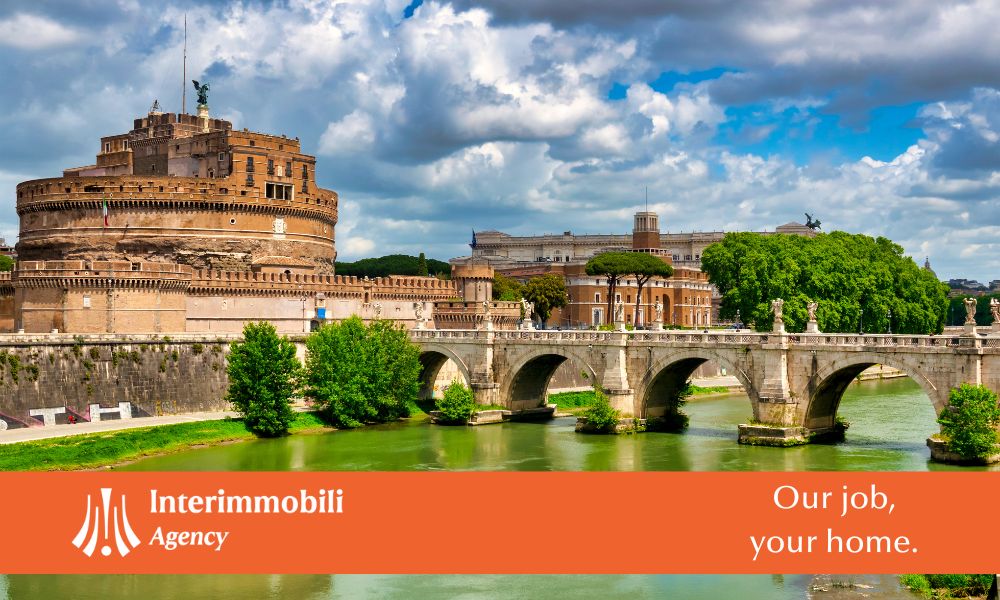
News
Living in Rome: artistic treasures and where to live
6/Mar/2023
Articles
An undisputed masterpiece of art and history, Rome is enhanced by a sky that is nearly always bright blue, the vicinity of the sea, magnificent art works and large nature parks. Its signature vibrancy, chaos and spirituality make it unique both as a tourist destination and a city to live in.
The city’s artistic heritage is exceptionally rich and familiar to all, especially some of its best known masterpieces: St. Peter’s Basilica, the Colosseum and the Trevi fountain. We have put together a list for you of some of lesser-known gems, to experience the city from our perspective.
In Rome, as in Turin, Genoa, Milan and Florence, we offer properties for sale or rent as a residence or a workplace.
What to visit in Rome
Castel Sant’Angelo
On the right-hand bank of the Tiber river, a short distance from the Vatican and built some 2000 years ago, sits Castel Sant’Angelo, also known as the Mausoleum of Hadrian. Originally built as a fortress, and having served over the years as a prison, a place of residence and, currently, a museum, it underwent various changes during the medieval era and the renaissance, while retaining traces of all stages of its entire ancient history.
A fortified elevated passageway, known as Passetto di Borgo, links it to the Vatican. The St. Angelo Bridge connects it to the city of Rome. Standing atop the structure is an impressive bronze sculpture of theArchangel Michael by Flemish sculptor Peter Anton van Verschaffelt (1752), while the Terrace of the Angel offers views over Rome from up high.
Villa Doria Pamphilj
Villa Doria Pamphilj is a picturesque park, owned by the Municipality of Rome, which surrounds one of the city’s most important aristocratic buildings. Originally used as a country estate by the Pamphili family, it was extended over the years to its current size of 180 hectares, and houses a building surrounded by gardens, a pine forest and a farm. Its vegetation also earned it the name “Bel Respiro” (Deep Breath) after the Casino del Bel Respiro, also known as Palazzina dell’Algardi in honour of its designer Casino del Bel Respiro was acquired in 1967 by the Italian State Property Office and is currently the representative office of the Italian Prime Minister’s Department; visits can be booked.
Orange Garden
Rome has an abundance of romantic locations, but Giardino degli Aranci (Orange Garden), also known as Parco Savello, is worth a visit to experience the feeling of watching the great, majestic city from a secluded, almost mysterious garden.
Originally a Savelli-family fortress, it was subsequently donated to the Dominican friars, who transformed it into a garden. The first orange tree was introduced from Spain by San Domenico di Guzman, one of the friars, in the 13th century and, over time, the space was transformed into an orange garden. It was redesigned in the 20th century by architect Raffaele Del Vico, who included a boulevard lined with bitter orange plants, leading slowly towards the viewing point that looks out over Rome.
Caracalla baths
This awesome site offers first-hand evidence that modern spas have their origins way back in 217 A.D. We have Emperor Caracalla to thank for the relaxation and wellness spaces that we continue to enjoy to this day.
The large archaeological site, which spanned approximately 11 hectares, is today in a good state of repair. The plan and perimeter walls allow visitors to explore the ancient wellness route consisting of the frigidarium, calidarium and natatio, an open-air pool. It is clear that the baths were rich and luxurious, with columns and niches made from marble and colorful mosaics. While wandering through the site, a little imagination can easily evoke the atmosphere of the time.
It is fascinating to consider how the water supply, wooden furnaces used for heating, and drainage system worked.
The baths were surrounded by gardens and relaxation spaces, allowing the site to be used not only as a wellness space but also a place of meeting and exchange. A visit to the Caracalla baths is an experience not to be missed.
Living in Rome: houses for rent and for sale
It must be noted that Rome’s beauty and wealth of magnificent works is matched by its chaos and sub-optimal services. Choosing to live in Rome requires an open mindset and the organizational skills to arrange travel to and from work and to keep up with day-to-day commitments.
There are plenty of work opportunities on offer in the city, as it is home to large multinational companies, and it boasts accommodation to suit all needs. Unlike in Milan, reasonably priced properties can also be found in central areas. There is plenty of green space on offer on the outskirts of the city, as well as access to the sea for those who are interested.
We have exclusive and quality apartments available in Nomentano, home to “La Sapienza”, one of Italy’s oldest universities, as well as the Villa Torlonia museums and the Villa Massimo, German cultural institute. The complex has a unique style and is equipped with all modern conveniences, from automation systems to reserved bike parking, and makes living in Rome easy.
Find out more:
Article by: Interimmobili Agency studies office
